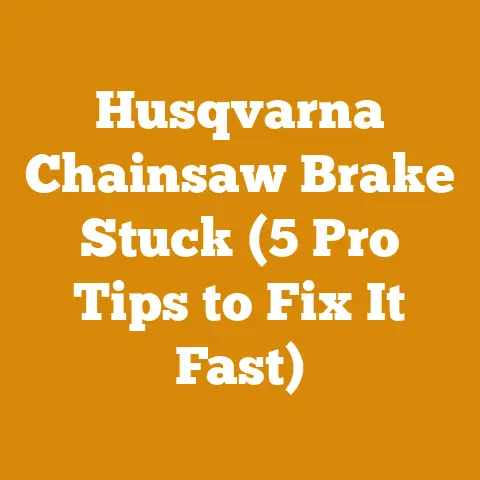Cost of Tree Removal and Stump Grinding (5 Pro Arborist Insights)
Imagine you’ve got a majestic oak in your front yard, a real beauty, shading your house on those scorching summer days. It’s been there for decades, maybe even longer than you’ve owned the place. But lately, you’ve noticed some worrying signs – dead branches, maybe some fungal growth at the base. Or perhaps, a recent storm has left it leaning precariously, threatening your home or your neighbor’s. Now, you’re faced with a tough decision: tree removal. And that brings up the inevitable question: what’s it going to cost? And what about that unsightly stump that’s going to be left behind?
The cost of tree removal and stump grinding can feel like a bit of a black box. There are so many variables involved, and it’s hard to know if you’re getting a fair price. I’ve been in the wood processing and tree care industry for over 15 years, and I’ve seen homeowners blindsided by unexpected costs and confused by the whole process. I’ve also seen them get ripped off.
That’s why I’m writing this guide. I want to pull back the curtain and give you an insider’s look at how tree removal and stump grinding costs are determined. I’ll share my experiences, pro tips, and data-backed insights to help you make informed decisions, avoid common pitfalls, and get the best possible value for your money. I’ll also share the insights of other arborists I’ve worked with over the years.
This isn’t just about saving money; it’s about ensuring the safety of your property and your family. A poorly executed tree removal can be disastrous, leading to property damage, injuries, or even fatalities. Choosing the right arborist and understanding the costs involved is crucial.
Key Takeaways You’ll Discover:
By the end of this article, you’ll be armed with the knowledge you need to navigate this process with confidence and get the job done right.
Understanding the True Cost of Tree Removal and Stump Grinding: 5 Pro Arborist Insights
1. Tree Size and Type: The Foundation of the Price
The size and type of tree are perhaps the most significant factors influencing the cost of removal. Think of it like this: removing a small sapling is a quick afternoon task, while felling a towering oak requires specialized equipment, a skilled crew, and a considerable amount of time.
- Tree Height: Taller trees necessitate more complex rigging and cutting techniques. They often require a crane or bucket truck, significantly increasing the labor and equipment costs.
- Trunk Diameter: A larger trunk means more wood to cut and dispose of. It also implies a more extensive root system, which impacts the stump grinding process.
- Tree Species: Some species are denser and harder to cut than others. For example, removing a mature oak or maple will typically cost more than removing a similar-sized pine or willow.
- Tree Weight: A dense, water-laden tree is more difficult and dangerous to remove than a dry, lightweight tree.
My Experience: I remember one job where we were tasked with removing a massive silver maple that had grown dangerously close to a client’s house. The tree was easily 80 feet tall with a trunk diameter of over 5 feet. We had to use a crane to carefully lower large sections of the tree to the ground, and the entire process took two full days. The cost was significantly higher than a typical tree removal, but the client understood that it was necessary to prevent potential damage to their home.
Data-Backed Insight: According to data from the Tree Care Industry Association (TCIA), the average cost to remove a tree ranges from \$150 to \$1,500, but this can vary widely depending on the factors mentioned above. Trees over 75 feet tall can easily cost \$1,000 or more to remove.
Pro Tip: When getting quotes, be sure to provide the arborist with accurate information about the tree’s size and species. This will help them provide a more accurate estimate and avoid any surprises down the road. If you’re unsure about the tree’s species, take a few pictures of the leaves, bark, and overall shape and send them to the arborist.
2. Location, Location, Location: Accessibility Matters
The location of the tree plays a crucial role in determining the complexity and cost of the removal process. A tree that’s easily accessible with ample space around it is far less challenging (and therefore less expensive) to remove than a tree that’s surrounded by obstacles or located in a difficult-to-reach area.
- Proximity to Structures: Trees growing close to houses, fences, power lines, or other structures require extra care and precision during removal. Arborists may need to use specialized rigging techniques to avoid damaging these structures.
- Accessibility for Equipment: Can the arborist easily get a bucket truck, crane, or chipper to the tree? If not, they may need to use manual methods, which can be more time-consuming and labor-intensive.
- Terrain: Trees located on steep slopes, in swampy areas, or in other difficult terrain can be more challenging to remove. This may require specialized equipment or techniques.
- Underground Utilities: The presence of underground utilities (gas lines, water pipes, electrical cables) can complicate the removal process and require careful planning to avoid damage.
My Experience: I once had a job where we had to remove a large oak tree that was growing in a client’s backyard. The problem was, the only access to the backyard was through a narrow gate that was only wide enough for a wheelbarrow. We couldn’t get any of our equipment back there, so we had to cut the tree down in small sections and haul them out by hand. It was a grueling job that took much longer than expected, and the cost reflected the added difficulty.
Data-Backed Insight: A study by the International Society of Arboriculture (ISA) found that trees located in confined spaces or near structures can increase removal costs by 20-50%.
Pro Tip: When describing the location of the tree to the arborist, be as detailed as possible. Mention any obstacles, access limitations, or potential hazards. Take pictures or videos of the site and send them to the arborist to give them a better understanding of the situation.
3. Tree Condition: Health and Stability Impact the Price
The health and stability of the tree are critical factors that influence the complexity and safety of the removal process. A healthy, structurally sound tree is generally easier and safer to remove than a tree that’s dead, diseased, or damaged.
- Dead or Decaying Wood: Trees with extensive dead or decaying wood are more likely to break apart during removal, posing a safety hazard to the crew and surrounding property.
- Disease or Infestation: Certain diseases or infestations can weaken the tree’s structure and make it more difficult to remove. For example, trees infected with emerald ash borer (EAB) are notoriously brittle and prone to splitting.
- Structural Defects: Trees with structural defects such as cracks, cavities, or weak branch unions are more likely to fail during removal.
- Leaning or Unstable Trees: Trees that are leaning or unstable pose a significant risk during removal, as they could fall in an unpredictable direction.
My Experience: I once had to remove a large ash tree that had been heavily infested with emerald ash borer. The tree was so brittle that it started to crumble as soon as we started cutting into it. We had to use extra caution and rigging to prevent the tree from falling apart and causing damage.
Data-Backed Insight: According to the USDA Forest Service, trees with significant decay or structural defects can increase removal costs by 30-70%.
Pro Tip: Have the arborist assess the tree’s condition before providing a quote. They should be able to identify any potential hazards or complications that could affect the removal process. Ask them to explain their assessment and how it will impact the cost.
4. Stump Grinding: Diameter, Depth, and Root System Complexity
Stump grinding is the process of removing the remaining stump after a tree has been cut down. The cost of stump grinding depends on several factors, including the stump’s diameter, the depth to which it needs to be ground, and the complexity of the root system.
- Stump Diameter: Larger stumps require more time and effort to grind, as they involve more wood to remove.
- Grinding Depth: The depth to which the stump needs to be ground depends on the client’s preferences and the intended use of the area. For example, if the area will be replanted with grass, the stump needs to be ground below the surface. If the area will be paved over, the stump may need to be ground even deeper.
- Root System Complexity: Stumps with extensive or complex root systems can be more difficult to grind, as the roots may extend far beyond the stump itself.
- Accessibility: Just like with tree removal, the accessibility of the stump can affect the cost of grinding. Stumps located in difficult-to-reach areas may require specialized equipment or techniques.
My Experience: I remember one job where we had to grind a large oak stump that was located in a client’s front yard. The stump was about 4 feet in diameter, and the root system was incredibly complex. We had to use a large stump grinder and spend several hours carefully grinding the stump and roots. The cost was higher than a typical stump grinding job, but the client was happy with the results.
Data-Backed Insight: According to data from HomeAdvisor, the average cost to grind a stump ranges from \$75 to \$400, but this can vary widely depending on the factors mentioned above.
Pro Tip: When getting quotes for stump grinding, be sure to specify the desired grinding depth. Also, ask the arborist about their method for handling the grindings (the wood chips produced during the grinding process). Some arborists will remove the grindings, while others will leave them on site.
5. The Arborist’s Expertise and Insurance: Peace of Mind Comes at a Price
While it might be tempting to go with the cheapest tree removal service you can find, it’s crucial to consider the arborist’s expertise, insurance coverage, and overall reputation. Hiring a qualified and insured arborist may cost more upfront, but it can save you a lot of headaches (and money) in the long run.
- Certification: Look for arborists who are certified by the International Society of Arboriculture (ISA). ISA certification indicates that the arborist has met certain standards of knowledge and experience.
- Insurance: Make sure the arborist carries adequate liability insurance and workers’ compensation insurance. This will protect you from financial liability in case of accidents or property damage.
- Experience: Choose an arborist with a proven track record of successful tree removals. Ask for references and check online reviews.
- Equipment: A reputable arborist will have the necessary equipment to safely and efficiently remove trees. This may include bucket trucks, cranes, chippers, and stump grinders.
- Permits: Depending on your location, you may need a permit to remove a tree. A reputable arborist will be familiar with local regulations and can help you obtain the necessary permits.
My Experience: I’ve seen firsthand the consequences of hiring unqualified tree removal services. I once had a client who hired a “tree trimmer” who wasn’t properly insured. During the removal process, a large branch fell and damaged the client’s fence. The “tree trimmer” refused to pay for the damages, and the client was left to foot the bill.
Data-Backed Insight: According to the National Arbor Day Foundation, hiring a certified arborist can reduce the risk of property damage and personal injury by up to 50%.
Pro Tip: Don’t be afraid to ask the arborist about their qualifications, insurance coverage, and experience. A reputable arborist will be happy to provide you with this information. Also, be sure to get a written contract that clearly outlines the scope of work, the price, and the payment terms.
Diving Deeper: Unveiling Hidden Costs and Unexpected Complications
While the factors I’ve already discussed are the primary drivers of tree removal and stump grinding costs, there are often hidden costs and unexpected complications that can arise during the process. Being aware of these potential issues can help you avoid surprises and budget accordingly.
In many municipalities, you need a permit to remove a tree, especially if it’s a large or protected species. The cost of the permit can vary depending on your location and the size and type of tree. Failing to obtain the necessary permits can result in fines or even legal action.
- Local Ordinances: Check with your local government to determine if you need a permit to remove a tree on your property.
- Protected Species: Some tree species are protected by law, and you may need special permission to remove them.
- HOA Restrictions: If you live in a homeowners association (HOA), there may be additional restrictions on tree removal.
My Experience: I once had a client who removed a large oak tree without obtaining the necessary permits. They were fined several thousand dollars by the city and were required to plant a replacement tree.
Pro Tip: Ask the arborist if they are familiar with local tree removal regulations and if they can help you obtain the necessary permits.
Debris Removal: What Happens to the Wood?
The cost of tree removal typically includes the removal of the tree itself, but it may not include the removal of the debris (branches, leaves, and wood chips). Debris removal can be a significant expense, especially if you have a large tree or a lot of debris.
- Chipping: Chipping the branches and small pieces of wood is a common way to dispose of debris. The wood chips can be used as mulch or compost.
- Log Removal: If you want to keep the logs for firewood or other purposes, the arborist may charge extra to cut them into manageable sizes and load them onto your truck.
- Hauling: Hauling the debris away to a landfill or recycling center can be expensive, especially if you have a lot of debris.
My Experience: I often offer clients the option of keeping the wood chips for mulch. This can save them money on debris removal and provide them with a valuable resource for their garden.
Pro Tip: Discuss debris removal options with the arborist and get a clear understanding of what’s included in the price.
Unforeseen Complications: When Things Don’t Go According to Plan
Despite the best planning, unforeseen complications can sometimes arise during tree removal. These complications can add to the cost of the project.
- Hidden Utilities: Underground utilities (gas lines, water pipes, electrical cables) can be a major obstacle during tree removal. If the arborist encounters a hidden utility, they may need to stop work and contact the utility company to have it located and marked.
- Unexpected Damage: Accidents can happen during tree removal, and property damage is always a risk. If the arborist damages your property or a neighbor’s property, you may need to file a claim with their insurance company.
- Inclement Weather: Inclement weather (rain, snow, high winds) can delay tree removal and add to the cost of the project.
My Experience: I once had a job where we were removing a tree near a client’s house when we accidentally damaged their underground sprinkler system. We had to stop work and call a plumber to repair the sprinkler system, which added to the cost of the project.
Pro Tip: Ask the arborist about their contingency plan for dealing with unforeseen complications. Also, make sure they have adequate insurance coverage to protect you from financial liability in case of accidents or property damage.
Beyond the Basics: Exploring Advanced Techniques and Specialized Services
While basic tree removal and stump grinding are relatively straightforward processes, there are some advanced techniques and specialized services that may be required in certain situations. Understanding these options can help you make informed decisions and get the best possible results.
Crane-Assisted Tree Removal: When Precision is Paramount
In situations where a tree is located close to structures or in a difficult-to-reach area, crane-assisted tree removal may be the safest and most efficient option. This technique involves using a crane to lift large sections of the tree and lower them to the ground, minimizing the risk of damage to surrounding property.
- Tight Spaces: Cranes can be used to remove trees in tight spaces where it would be impossible to maneuver a bucket truck or other equipment.
- Proximity to Structures: Cranes can be used to carefully lower sections of the tree over houses, fences, or other structures.
- Hazardous Trees: Cranes can be used to remove hazardous trees that are unstable or prone to falling apart.
My Experience: I’ve used crane-assisted tree removal on several occasions when dealing with large trees near houses. It’s a more expensive option, but it’s often the only way to safely and efficiently remove the tree.
Pro Tip: If you have a tree that’s located close to structures or in a difficult-to-reach area, ask the arborist if crane-assisted tree removal is an option.
Root Pruning and Root Barrier Installation: Protecting Your Property
In some cases, tree roots can cause damage to sidewalks, driveways, foundations, and underground utilities. Root pruning and root barrier installation can help prevent this damage.
- Root Pruning: Root pruning involves cutting back the roots of a tree to prevent them from growing into areas where they could cause damage.
- Root Barrier Installation: Root barrier installation involves installing a physical barrier in the ground to prevent tree roots from spreading.
My Experience: I’ve installed root barriers around several trees to protect clients’ sidewalks and driveways. It’s a relatively simple process that can save a lot of money in the long run by preventing costly repairs.
Pro Tip: If you’re concerned about tree roots damaging your property, ask the arborist about root pruning and root barrier installation.
Tree Cabling and Bracing: Preserving Valuable Trees
In some cases, it may be possible to preserve a valuable tree by cabling or bracing it. This involves installing cables or braces to support weak branches or stems and prevent them from breaking.
- Weak Branch Unions: Cabling and bracing can be used to support weak branch unions and prevent them from failing.
- Split Trunks: Cabling and bracing can be used to stabilize split trunks and prevent them from separating.
- Leaning Trees: Cabling and bracing can be used to support leaning trees and prevent them from falling.
My Experience: I’ve cabled and braced several trees to help clients preserve them. It’s a good option for trees that have sentimental value or that provide important shade or habitat.
Pro Tip: If you have a tree that’s showing signs of weakness or instability, ask the arborist about cabling and bracing.
Get Multiple Quotes: Comparison is Key
The most important thing you can do to save money on tree removal and stump grinding is to get multiple quotes from different arborists. Comparing bids will give you a sense of the going rate for the work and allow you to negotiate a better price.
- Contact at Least Three Arborists: Aim to get quotes from at least three different arborists.
- Provide Detailed Information: Give each arborist the same detailed information about the tree and the scope of work.
- Compare Apples to Apples: Make sure the quotes are for the same services.
My Experience: I’ve seen clients save hundreds, even thousands, of dollars by getting multiple quotes. Don’t be afraid to shop around.
Pro Tip: When comparing quotes, don’t just focus on the bottom line. Consider the arborist’s qualifications, insurance coverage, and reputation.
Be Flexible with Timing: Off-Season Savings
Tree removal services are often in high demand during the spring and summer months. If you can be flexible with your timing, you may be able to get a better price by scheduling the work during the off-season (fall or winter).
- Demand is Lower: Demand for tree removal services is typically lower during the off-season, which means arborists may be more willing to negotiate on price.
- Weather Considerations: Be aware that weather conditions can sometimes delay tree removal during the off-season.
My Experience: I often offer discounts to clients who schedule tree removal during the winter months. It’s a win-win situation for both of us.
Pro Tip: Ask the arborist if they offer any discounts for off-season work.
Consider Bundling Services: Package Deals
If you need both tree removal and stump grinding, consider bundling the services with the same arborist. You may be able to get a better price by purchasing a package deal.
- Negotiating Power: Bundling services gives you more negotiating power.
- Efficiency: The arborist can often complete both services more efficiently if they’re done at the same time.
My Experience: I always offer a discount to clients who bundle tree removal and stump grinding. It’s more efficient for me, and it saves them money.
Pro Tip: Ask the arborist if they offer any package deals for tree removal and stump grinding.
Offer to Handle Debris Removal: DIY Savings
If you’re willing to handle the debris removal yourself, you can save money on the overall cost of the project.
- Chipping: You can rent a chipper and chip the branches and small pieces of wood yourself.
- Log Removal: You can cut the logs into manageable sizes and haul them away yourself.
My Experience: I’ve had clients who have saved a significant amount of money by handling the debris removal themselves.
Pro Tip: Be sure to factor in the cost of renting equipment and the time and effort required to handle the debris removal yourself.
Making the Right Choice: A Checklist for Hiring an Arborist
Choosing the right arborist is crucial for ensuring the safety of your property and your family. Here’s a checklist to help you make the right choice:
- Certification: Is the arborist certified by the International Society of Arboriculture (ISA)?
- Insurance: Does the arborist carry adequate liability insurance and workers’ compensation insurance?
- Experience: Does the arborist have a proven track record of successful tree removals?
- Equipment: Does the arborist have the necessary equipment to safely and efficiently remove trees?
- References: Can the arborist provide you with references from past clients?
- Reviews: What do online reviews say about the arborist’s work?
- Permits: Is the arborist familiar with local tree removal regulations and can they help you obtain the necessary permits?
- Contract: Will the arborist provide you with a written contract that clearly outlines the scope of work, the price, and the payment terms?
- Communication: Is the arborist responsive to your questions and concerns?
- Professionalism: Does the arborist present themselves in a professional manner?
Conclusion: Empowering You to Make Informed Decisions
Navigating the world of tree removal and stump grinding can seem daunting, but with the knowledge you’ve gained from this guide, you’re now well-equipped to make informed decisions and get the best possible value for your money.
Remember, the cost of tree removal and stump grinding is influenced by several factors, including the tree’s size, location, condition, and species, as well as the complexity of the stump grinding process. By understanding these factors and following the tips I’ve shared, you can avoid common pitfalls and negotiate a fair price.
Most importantly, remember that safety should always be your top priority. Hiring a qualified and insured arborist is essential for ensuring the safety of your property and your family. Don’t be afraid to ask questions, check references, and get multiple quotes before making a decision.
Actionable Next Steps:
- Assess Your Tree: Take a close look at the tree you need removed. Note its size, location, condition, and any potential hazards.
- Research Local Arborists: Search online for certified arborists in your area and check their reviews.
- Get Multiple Quotes: Contact at least three arborists and request a detailed quote.
- Compare Quotes Carefully: Compare the quotes based on price, services included, and the arborist’s qualifications and insurance coverage.
- Choose the Right Arborist: Select the arborist who best meets your needs and budget.
- Get a Written Contract: Make sure you have a written contract that clearly outlines the scope of work, the price, and the payment terms.
- Schedule the Work: Schedule the tree removal and stump grinding at a time that’s convenient for you.
- Supervise the Work: Keep an eye on the work as it’s being done to ensure that it’s being done safely and according to the contract.
- Enjoy Your New Space: Once the tree is removed and the stump is ground, you can enjoy your new space and plant a new tree or use the area for other purposes.
By following these steps, you can ensure that your tree removal and stump grinding project is a success. Good luck!






